Lectures no 20: Modern epoch Questions: 1.
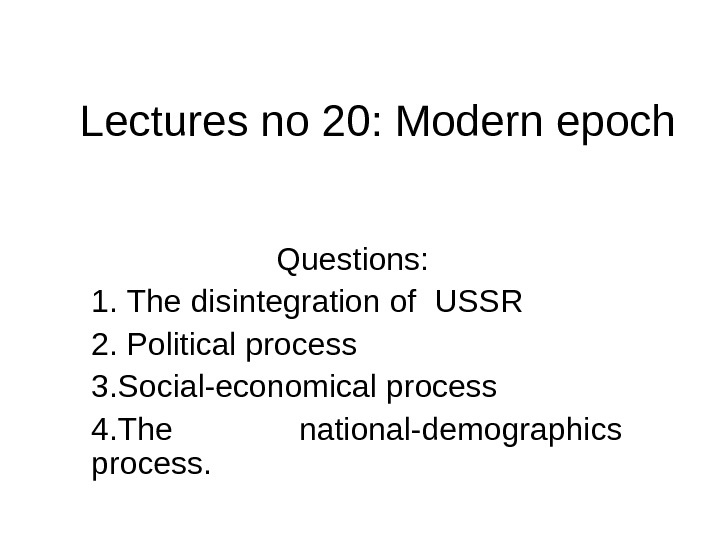
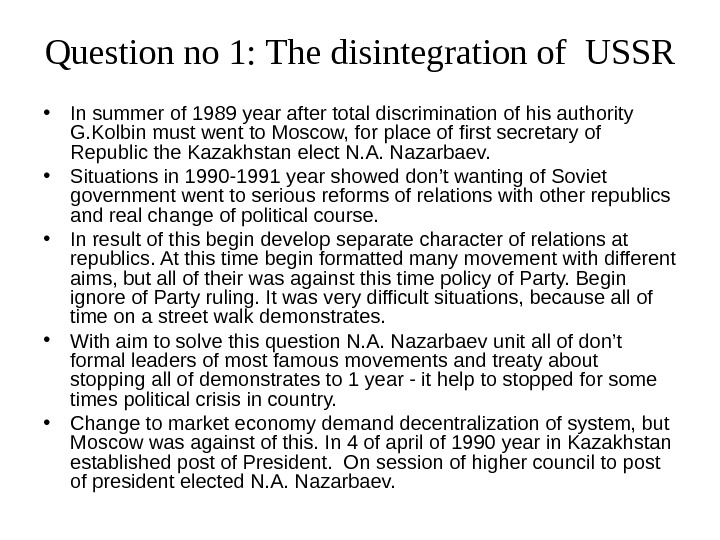
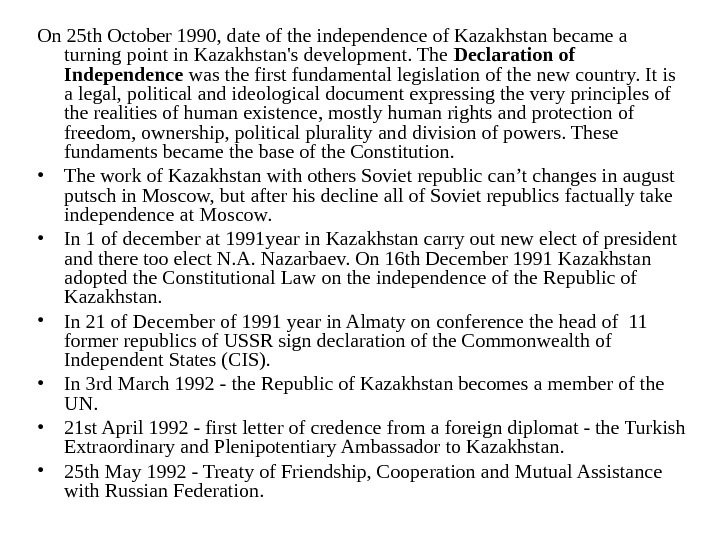
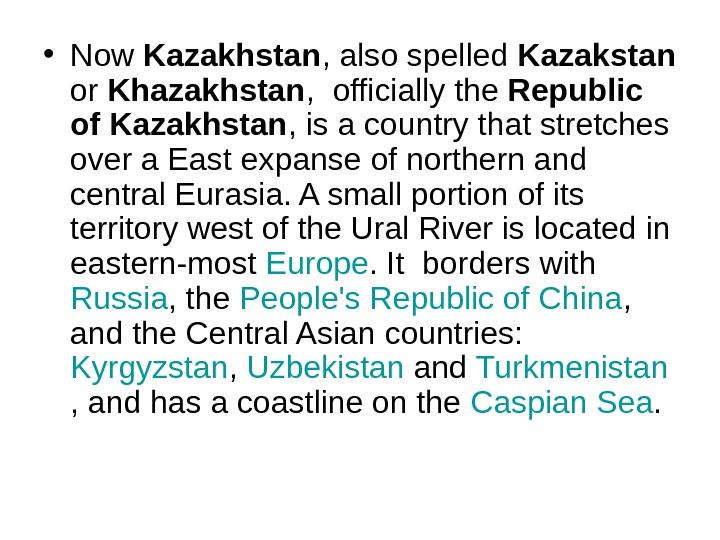
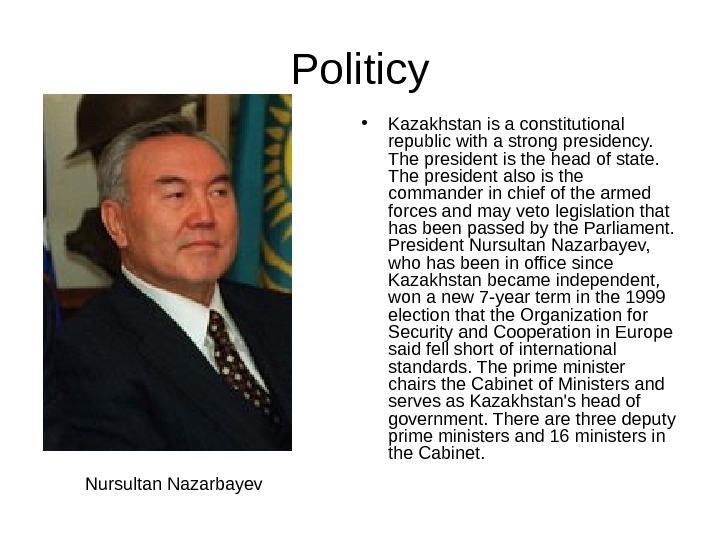

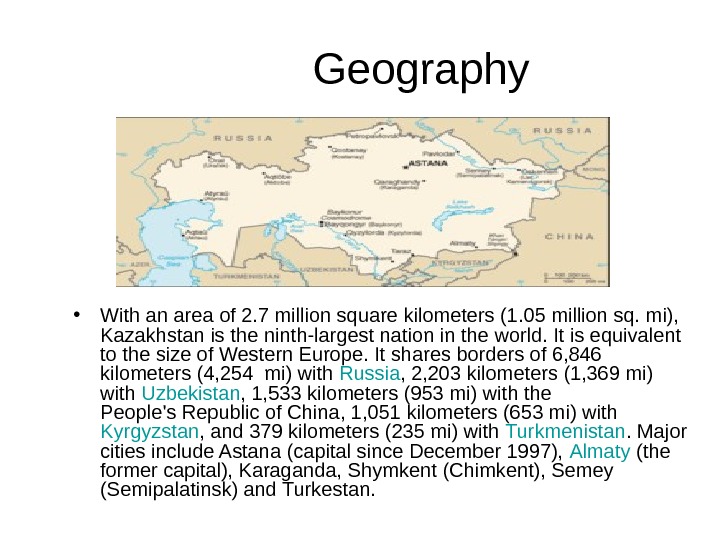
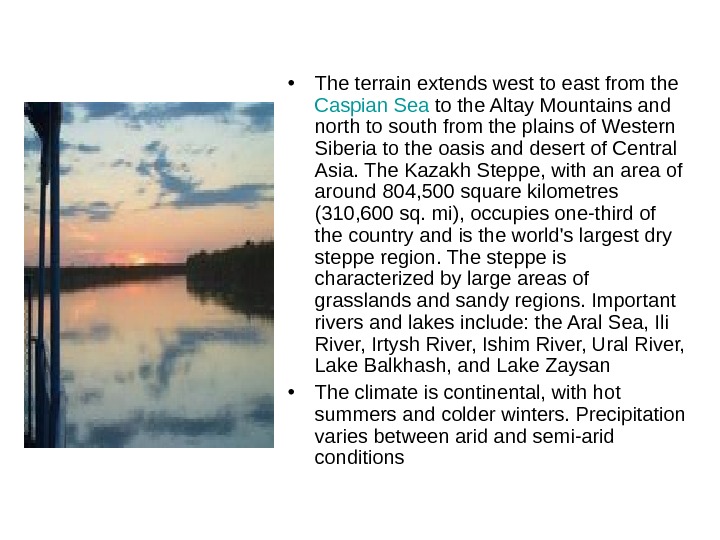

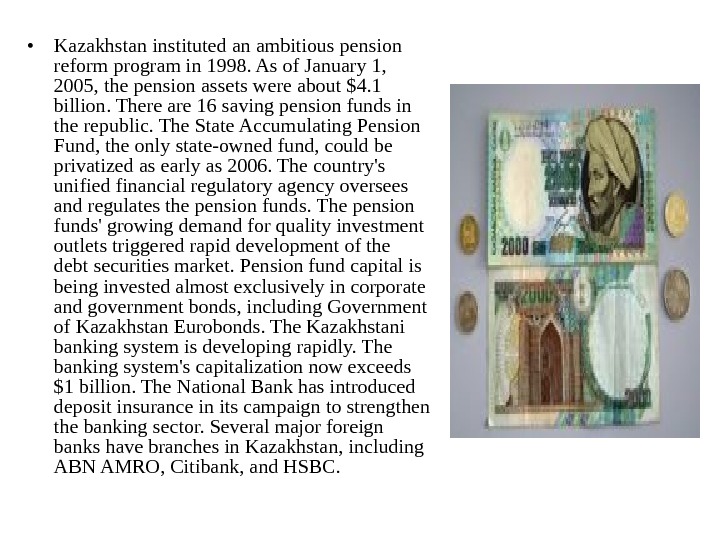
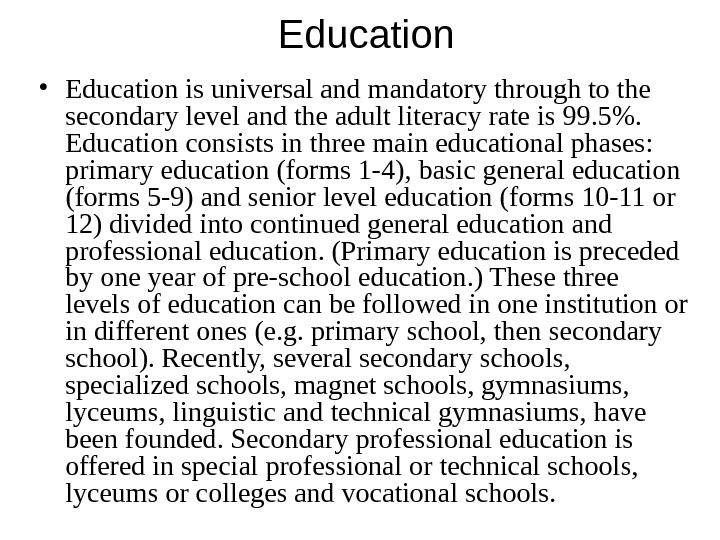
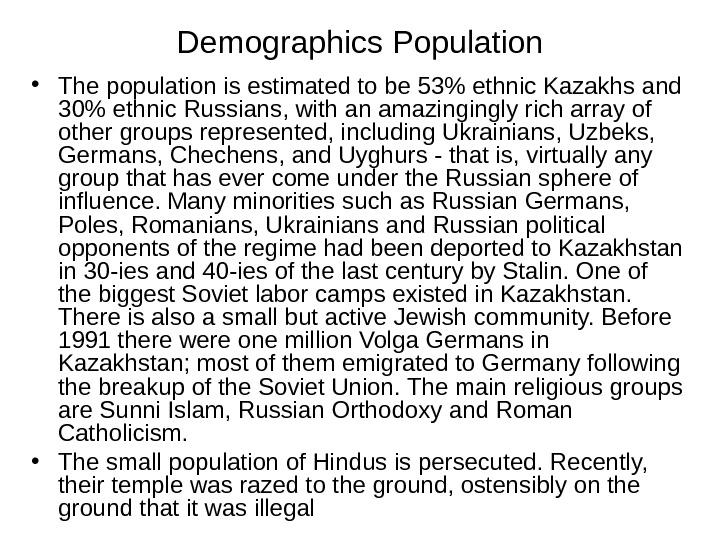
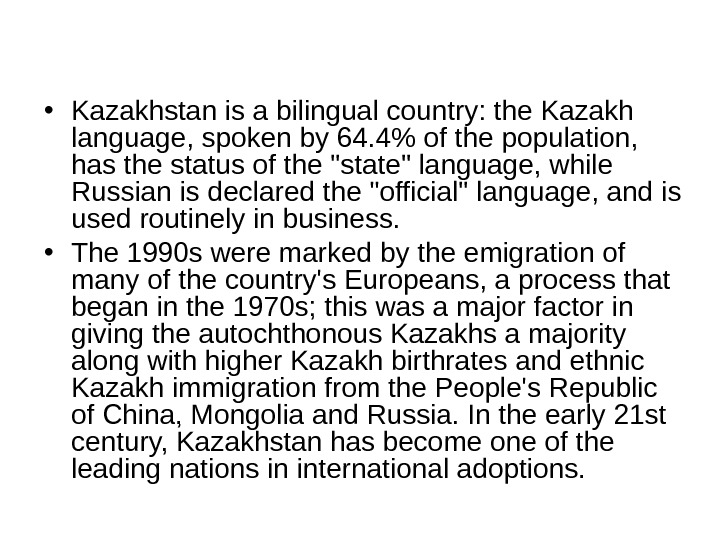
- Размер: 310 Кб
- Количество слайдов: 13
Описание презентации Lectures no 20: Modern epoch Questions: 1. по слайдам
 Lectures no 20: Modern epoch Questions: 1. The disintegration of USSR 2. Political process 3. Social-economical process 4. The national-demographics process.
Lectures no 20: Modern epoch Questions: 1. The disintegration of USSR 2. Political process 3. Social-economical process 4. The national-demographics process.
 Question no 1 : The disintegration of USSR • In summer of 1989 year after total discrimination of his authority G. Kolbin must went to Moscow, for place of first secretary of Republic the Kazakhstan elect N. A. Nazarbaev. • Situations in 1990 -1991 year showed don’t wanting of Soviet government went to serious reforms of relations with other republics and real change of political course. • In result of this begin develop separate character of relations at republics. At this time begin formatted many movement with different aims, but all of their was against this time policy of Party. Begin ignore of Party ruling. It was very difficult situations, because all of time on a street walk demonstrates. • With aim to solve this question N. A. Nazarbaev unit all of don’t formal leaders of most famous movements and treaty about stopping all of demonstrates to 1 year — it help to stopped for some times political crisis in country. • Change to market economy demand decentralization of system, but Moscow was against of this. In 4 of april of 1990 year in Kazakhstan established post of President. On session of higher council to post of president elected N. A. Nazarbaev.
Question no 1 : The disintegration of USSR • In summer of 1989 year after total discrimination of his authority G. Kolbin must went to Moscow, for place of first secretary of Republic the Kazakhstan elect N. A. Nazarbaev. • Situations in 1990 -1991 year showed don’t wanting of Soviet government went to serious reforms of relations with other republics and real change of political course. • In result of this begin develop separate character of relations at republics. At this time begin formatted many movement with different aims, but all of their was against this time policy of Party. Begin ignore of Party ruling. It was very difficult situations, because all of time on a street walk demonstrates. • With aim to solve this question N. A. Nazarbaev unit all of don’t formal leaders of most famous movements and treaty about stopping all of demonstrates to 1 year — it help to stopped for some times political crisis in country. • Change to market economy demand decentralization of system, but Moscow was against of this. In 4 of april of 1990 year in Kazakhstan established post of President. On session of higher council to post of president elected N. A. Nazarbaev.
 On 25 th October 1990, date of the independence of Kazakhstan became a turning point in Kazakhstan’s development. The Declaration of Independence was the first fundamental legislation of the new country. It is a legal, political and ideological document expressing the very principles of the realities of human existence, mostly human rights and protection of freedom, ownership, political plurality and division of powers. These fundaments became the base of the Constitution. • The work of Kazakhstan with others Soviet republic can’t changes in august putsch in Moscow, but after his decline all of Soviet republics factually take independence at Moscow. • In 1 of december at 1991 year in Kazakhstan carry out new elect of president and there too elect N. A. Nazarbaev. On 16 th December 1991 Kazakhstan adopted the Constitutional Law on the independence of the Republic of Kazakhstan. • In 21 of December of 1991 year in Almaty on conference the head of 11 former republics of USSR sign declaration of the Commonwealth of Independent States (CIS). • In 3 rd March 1992 — the Republic of Kazakhstan becomes a member of the UN. • 21 st April 1992 — first letter of credence from a foreign diplomat — the Turkish Extraordinary and Plenipotentiary Ambassador to Kazakhstan. • 25 th May 1992 — Treaty of Friendship, Cooperation and Mutual Assistance with Russian Federation.
On 25 th October 1990, date of the independence of Kazakhstan became a turning point in Kazakhstan’s development. The Declaration of Independence was the first fundamental legislation of the new country. It is a legal, political and ideological document expressing the very principles of the realities of human existence, mostly human rights and protection of freedom, ownership, political plurality and division of powers. These fundaments became the base of the Constitution. • The work of Kazakhstan with others Soviet republic can’t changes in august putsch in Moscow, but after his decline all of Soviet republics factually take independence at Moscow. • In 1 of december at 1991 year in Kazakhstan carry out new elect of president and there too elect N. A. Nazarbaev. On 16 th December 1991 Kazakhstan adopted the Constitutional Law on the independence of the Republic of Kazakhstan. • In 21 of December of 1991 year in Almaty on conference the head of 11 former republics of USSR sign declaration of the Commonwealth of Independent States (CIS). • In 3 rd March 1992 — the Republic of Kazakhstan becomes a member of the UN. • 21 st April 1992 — first letter of credence from a foreign diplomat — the Turkish Extraordinary and Plenipotentiary Ambassador to Kazakhstan. • 25 th May 1992 — Treaty of Friendship, Cooperation and Mutual Assistance with Russian Federation.
 • Now Kazakhstan , also spelled Kazakstan or Khazakhstan , officially the Republic of Kazakhstan , is a country that stretches over a East expanse of northern and central Eurasia. A small portion of its territory west of the Ural River is located in eastern-most Europe. It borders with Russia , the People’s Republic of China , and the Central Asian countries : Kyrgyzstan , Uzbekistan and Turkmenistan , and has a coastline on the Caspian Sea.
• Now Kazakhstan , also spelled Kazakstan or Khazakhstan , officially the Republic of Kazakhstan , is a country that stretches over a East expanse of northern and central Eurasia. A small portion of its territory west of the Ural River is located in eastern-most Europe. It borders with Russia , the People’s Republic of China , and the Central Asian countries : Kyrgyzstan , Uzbekistan and Turkmenistan , and has a coastline on the Caspian Sea.
 Politicy • Kazakhstan is a constitutional republic with a strong presidency. The president is the head of state. The president also is the commander in chief of the armed forces and may veto legislation that has been passed by the Parliament. President Nursultan Nazarbayev, who has been in office since Kazakhstan became independent, won a new 7 -year term in the 1999 election that the Organization for Security and Cooperation in Europe said fell short of international standards. The prime minister chairs the Cabinet of Ministers and serves as Kazakhstan’s head of government. There are three deputy prime ministers and 16 ministers in the Cabinet. Nursultan Nazarbayev
Politicy • Kazakhstan is a constitutional republic with a strong presidency. The president is the head of state. The president also is the commander in chief of the armed forces and may veto legislation that has been passed by the Parliament. President Nursultan Nazarbayev, who has been in office since Kazakhstan became independent, won a new 7 -year term in the 1999 election that the Organization for Security and Cooperation in Europe said fell short of international standards. The prime minister chairs the Cabinet of Ministers and serves as Kazakhstan’s head of government. There are three deputy prime ministers and 16 ministers in the Cabinet. Nursultan Nazarbayev
 • Kazakhstan has a bicameral Parliament, made up of the lower house (the Majilis) and upper house (the Senate). Single mandate districts popularly elect 67 seats in the Majilis; there also are ten members elected by party-list vote rather than by single mandate districts. The Senate has 39 members. Two senators are selected by each of the elected assemblies ( Maslikhats) of Kazakhstan’s 16 principal administrative divisions (14 regions, or oblasts, plus the cities of Astana and Almaty). The president appoints the remaining seven senators. Majilis deputies and the government both have the right of legislative initiative, though the government proposes most legislation considered by the Parliament.
• Kazakhstan has a bicameral Parliament, made up of the lower house (the Majilis) and upper house (the Senate). Single mandate districts popularly elect 67 seats in the Majilis; there also are ten members elected by party-list vote rather than by single mandate districts. The Senate has 39 members. Two senators are selected by each of the elected assemblies ( Maslikhats) of Kazakhstan’s 16 principal administrative divisions (14 regions, or oblasts, plus the cities of Astana and Almaty). The president appoints the remaining seven senators. Majilis deputies and the government both have the right of legislative initiative, though the government proposes most legislation considered by the Parliament.
 Geography • With an area of 2. 7 million square kilometers (1. 05 million sq. mi), Kazakhstan is the ninth-largest nation in the world. It is equivalent to the size of Western Europe. It shares borders of 6, 846 kilometers (4, 254 mi) with Russia , 2, 203 kilometers (1, 369 mi) with Uzbekistan , 1, 533 kilometers (953 mi) with the People’s Republic of China , 1, 051 kilometers (653 mi) with Kyrgyzstan , and 379 kilometers (235 mi) with Turkmenistan. Major cities include Astana (capital since December 1997), Almaty (the former capital), Karaganda, Shymkent (Chimkent), Semey (Semipalatinsk) and Turkestan.
Geography • With an area of 2. 7 million square kilometers (1. 05 million sq. mi), Kazakhstan is the ninth-largest nation in the world. It is equivalent to the size of Western Europe. It shares borders of 6, 846 kilometers (4, 254 mi) with Russia , 2, 203 kilometers (1, 369 mi) with Uzbekistan , 1, 533 kilometers (953 mi) with the People’s Republic of China , 1, 051 kilometers (653 mi) with Kyrgyzstan , and 379 kilometers (235 mi) with Turkmenistan. Major cities include Astana (capital since December 1997), Almaty (the former capital), Karaganda, Shymkent (Chimkent), Semey (Semipalatinsk) and Turkestan.
 • The terrain extends west to east from the Caspian Sea to the Altay Mountains and north to south from the plains of Western Siberia to the oasis and desert of Central Asia. The Kazakh Steppe, with an area of around 804, 500 square kilometres (310, 600 sq. mi), occupies one-third of the country and is the world’s largest dry steppe region. The steppe is characterized by large areas of grasslands and sandy regions. Important rivers and lakes include: the Aral Sea, Ili River, Irtysh River, Ishim River, Ural River, Lake Balkhash, and Lake Zaysan • The climate is continental, with hot summers and colder winters. Precipitation varies between arid and semi-arid conditions
• The terrain extends west to east from the Caspian Sea to the Altay Mountains and north to south from the plains of Western Siberia to the oasis and desert of Central Asia. The Kazakh Steppe, with an area of around 804, 500 square kilometres (310, 600 sq. mi), occupies one-third of the country and is the world’s largest dry steppe region. The steppe is characterized by large areas of grasslands and sandy regions. Important rivers and lakes include: the Aral Sea, Ili River, Irtysh River, Ishim River, Ural River, Lake Balkhash, and Lake Zaysan • The climate is continental, with hot summers and colder winters. Precipitation varies between arid and semi-arid conditions
 Economy • The government of Kazakhstan plans to double its Gross domestic product (GDP) by 2008 and triple by 2015 compared to 2000. The GDP growth was stable in the East five years, and was higher than 9%. GDP growth in 2005 was 9. 2%, and 9. 4% in 2004. Kazakhstan’s economy grew by 9. 2% in 2003, buoyed by high world crude oil prices. GDP grew 9. 5% in 2002; it grew 13. 2% in 2001, up from 9. 8% in
Economy • The government of Kazakhstan plans to double its Gross domestic product (GDP) by 2008 and triple by 2015 compared to 2000. The GDP growth was stable in the East five years, and was higher than 9%. GDP growth in 2005 was 9. 2%, and 9. 4% in 2004. Kazakhstan’s economy grew by 9. 2% in 2003, buoyed by high world crude oil prices. GDP grew 9. 5% in 2002; it grew 13. 2% in 2001, up from 9. 8% in
 • Kazakhstan instituted an ambitious pension reform program in 1998. As of January 1, 2005, the pension assets were about $4. 1 billion. There are 16 saving pension funds in the republic. The State Accumulating Pension Fund, the only state-owned fund, could be privatized as early as 2006. The country’s unified financial regulatory agency oversees and regulates the pension funds. The pension funds’ growing demand for quality investment outlets triggered rapid development of the debt securities market. Pension fund capital is being invested almost exclusively in corporate and government bonds, including Government of Kazakhstan Eurobonds. The Kazakhstani banking system is developing rapidly. The banking system’s capitalization now exceeds $1 billion. The National Bank has introduced deposit insurance in its campaign to strengthen the banking sector. Several major foreign banks have branches in Kazakhstan, including ABN AMRO, Citibank, and HSBC.
• Kazakhstan instituted an ambitious pension reform program in 1998. As of January 1, 2005, the pension assets were about $4. 1 billion. There are 16 saving pension funds in the republic. The State Accumulating Pension Fund, the only state-owned fund, could be privatized as early as 2006. The country’s unified financial regulatory agency oversees and regulates the pension funds. The pension funds’ growing demand for quality investment outlets triggered rapid development of the debt securities market. Pension fund capital is being invested almost exclusively in corporate and government bonds, including Government of Kazakhstan Eurobonds. The Kazakhstani banking system is developing rapidly. The banking system’s capitalization now exceeds $1 billion. The National Bank has introduced deposit insurance in its campaign to strengthen the banking sector. Several major foreign banks have branches in Kazakhstan, including ABN AMRO, Citibank, and HSBC.
 Education • Education is universal and mandatory through to the secondary level and the adult literacy rate is 99. 5%. Education consists in three main educational phases: primary education (forms 1 -4), basic general education (forms 5 -9) and senior level education (forms 10 -11 or 12) divided into continued general education and professional education. (Primary education is preceded by one year of pre-school education. ) These three levels of education can be followed in one institution or in different ones (e. g. primary school, then secondary school). Recently, several secondary schools, specialized schools, magnet schools, gymnasiums, lyceums, linguistic and technical gymnasiums, have been founded. Secondary professional education is offered in special professional or technical schools, lyceums or colleges and vocational schools.
Education • Education is universal and mandatory through to the secondary level and the adult literacy rate is 99. 5%. Education consists in three main educational phases: primary education (forms 1 -4), basic general education (forms 5 -9) and senior level education (forms 10 -11 or 12) divided into continued general education and professional education. (Primary education is preceded by one year of pre-school education. ) These three levels of education can be followed in one institution or in different ones (e. g. primary school, then secondary school). Recently, several secondary schools, specialized schools, magnet schools, gymnasiums, lyceums, linguistic and technical gymnasiums, have been founded. Secondary professional education is offered in special professional or technical schools, lyceums or colleges and vocational schools.
 Demographics Population • The population is estimated to be 53% ethnic Kazakhs and 30% ethnic Russians, with an amazingingly rich array of other groups represented, including Ukrainians, Uzbeks, Germans, Chechens, and Uyghurs — that is, virtually any group that has ever come under the Russian sphere of influence. Many minorities such as Russian Germans, Poles, Romanians, Ukrainians and Russian political opponents of the regime had been deported to Kazakhstan in 30 -ies and 40 -ies of the last century by Stalin. One of the biggest Soviet labor camps existed in Kazakhstan. There is also a small but active Jewish community. Before 1991 there were one million Volga Germans in Kazakhstan; most of them emigrated to Germany following the breakup of the Soviet Union. The main religious groups are Sunni Islam, Russian Orthodoxy and Roman Catholicism. • The small population of Hindus is persecuted. Recently, their temple was razed to the ground, ostensibly on the ground that it was illegal
Demographics Population • The population is estimated to be 53% ethnic Kazakhs and 30% ethnic Russians, with an amazingingly rich array of other groups represented, including Ukrainians, Uzbeks, Germans, Chechens, and Uyghurs — that is, virtually any group that has ever come under the Russian sphere of influence. Many minorities such as Russian Germans, Poles, Romanians, Ukrainians and Russian political opponents of the regime had been deported to Kazakhstan in 30 -ies and 40 -ies of the last century by Stalin. One of the biggest Soviet labor camps existed in Kazakhstan. There is also a small but active Jewish community. Before 1991 there were one million Volga Germans in Kazakhstan; most of them emigrated to Germany following the breakup of the Soviet Union. The main religious groups are Sunni Islam, Russian Orthodoxy and Roman Catholicism. • The small population of Hindus is persecuted. Recently, their temple was razed to the ground, ostensibly on the ground that it was illegal
 • Kazakhstan is a bilingual country: the Kazakh language, spoken by 64. 4% of the population, has the status of the «state» language, while Russian is declared the «official» language, and is used routinely in business. • The 1990 s were marked by the emigration of many of the country’s Europeans, a process that began in the 1970 s; this was a major factor in giving the autochthonous Kazakhs a majority along with higher Kazakh birthrates and ethnic Kazakh immigration from the People’s Republic of China, Mongolia and Russia. In the early 21 st century, Kazakhstan has become one of the leading nations in international adoptions.
• Kazakhstan is a bilingual country: the Kazakh language, spoken by 64. 4% of the population, has the status of the «state» language, while Russian is declared the «official» language, and is used routinely in business. • The 1990 s were marked by the emigration of many of the country’s Europeans, a process that began in the 1970 s; this was a major factor in giving the autochthonous Kazakhs a majority along with higher Kazakh birthrates and ethnic Kazakh immigration from the People’s Republic of China, Mongolia and Russia. In the early 21 st century, Kazakhstan has become one of the leading nations in international adoptions.
